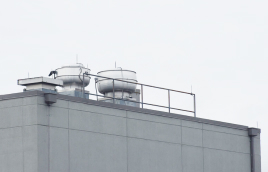Educational Facilities & Lightning Protection
Special Risk Factors:
In addition to the lightning hazards typical of all building, schools often have unique risks. In the case of lightning-caused fires, for example, evacuating schools – during a thunderstorm — can be especially difficult if they have places of assembly such as an auditorium and gymnasium with spectator seating, or due to the presence of pre-school, kindergarten, and special-needs students.
Communities depend on school buildings for shelter in the aftermath of disasters and expect schools to resume functioning as quickly as possible. Lightning protection systems for school buildings are more resilient so they are there when needed. School boards also appreciate that lightning protection systems are affordable and durable, making them a prudent use of the community’s resources.
Examples:

Lightning caused a fire at the Prospect School in Hempstead, NY. It forced the district to send students to other facilities across town while extensive fire, smoke, and water damage was repaired. Repairs cost over $10 million and took most of a school year.
Photo: Hempstead, NY Volunteer Fire Dept.
Watch Full Video Here: https://abc7ny.com/prospect-school-lightning-strike-long-island-nyc-weather/3908284/
"Fire department: McLane Middle School fire was caused by lightning"
Tampa Bay (FL) Times
"‘Extensive damage’ reported after Marian Central Catholic High School struck by lightning"
Lake and McHenry County (IL) Scanner
"Old Eastaboga School burns after likely lightning strike,"
ABC News, (Birmingham, AL)
https://abc3340.com/news/local/old-eastaboga-school-house-burns-after-apparent-lightning-strike
Does your building require lightning protection?
Design and Installation Considerations:
Lightning protection systems require a whole-building approach in accordance with nationally-recognized standards, including LPI 175, NFPA 780, and UL 96.
The standards require multiple paths to safely carry intense lightning surges between the sky and ground. This includes strategically located air terminals (lightning rods) at high points and on the roof, ground electrodes, and a network of heavy-duty lightning conductors to safely conduct current between them.
To equalize electrical potential throughout the building, the building’s plumbing, HVAC, structure, and other systems must be bonded to the lightning protection system, and the lightning protection grounding must be interconnected to the groundings for the building’s electrical and other systems. In addition, surge protective devices must be added to telephone, power, and other services entering the building.
Design and installation should be performed by individuals certified by the Lightning Protection Institute. For added assurance, installations should be certified by the LPI-Inspection Program to assure it functions as required. To make sure your lightning protection system remains in working order, have it inspected by a qualified lightning protection specialist every two to five years.
School administrators, teachers, and coaches must remember that it is their responsibility for protecting children against lightning and also applies to sports practice and other outdoor activities. As the National Weather Service and other public safety organizations urge, “When thunder roars, go indoors.” (Download a lightning safety poster here.)
Case Studies

Educational Facilities
School | Amherst, MA 01 / 03A lightning protection system protects this Amherst, MA school’s photovoltaic collectors as well as the building and its occupants. Like alternative energy systems, lightning protection is a forward-looking step towards building sustainability and resilience. Photo: Smokestack Lightning, Inc.
More About Lightning Protection
Educational Facilities
Wildwood Elementary and Middle School | Baltimore, MD 02 / 03A lightning protection system was installed during the renovation of an addition to the Wildwood Elementary and Middle School in Baltimore, MD. Photo: Dillion Lightning Protection Systems, Inc.
More About Lightning Protection
Educational Facilities
Cass Technical High School | Detroit, MI 03 / 03The cost of a lightning protection system is determined, in part, by roof area. This means that multi-story schools like Cass Technical High School in Detroit, MI have a lower cost per square foot of floor area. Photo: Guardian Lightning Protection
More About Lightning ProtectionOur Partner:

visit www.sls-us.com to learn about their suite of lightning solutions for special applications



